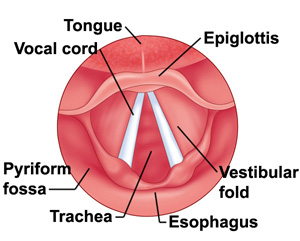John Mayer’s “Vow of Silence”

No John Mayer is NOT entering a monastery.
But he has sworn to total voice rest after undergoing a second surgery to remove a granuloma on his vocal cord.
As he wrote on his tumbr page:
Well, here I am. Silent for the next few months, no singing for probably six, but all signs point to this being the last step in getting to perform again. Back to notebooks and iPad to communicate for the time being.
The 34-year-old has been plagued by vocal problems since Sept. 2011. He underwent surgery to remove a granuloma one month later.
In March 2012, he had to suspend his tour “indefinitely” to rest his voice.
What are the vocal cords?
 The vocal cords are two folds of smooth muscle within the voice box (larynx). The larynx lies at the top of the windpipe (trachea), just below the back of the tongue. Air passing through the vocal cords causes them to vibrate, and produce the sound of your voice.
The vocal cords are two folds of smooth muscle within the voice box (larynx). The larynx lies at the top of the windpipe (trachea), just below the back of the tongue. Air passing through the vocal cords causes them to vibrate, and produce the sound of your voice.
What are vocal cord granulomas?
A granuloma is a benign noncancerous growth which is usually found at the back of the vocal fold. There isn’t a lot of soft tissue there to act as a cushion, making it more prone to trauma as the vocal folds vibrate against each other during talking or singing.
Vocal abuse or misuse, such as excessive use of the voice when singing, talking, smoking, coughing, yelling, or inhaling irritants can cause abnormalities of the vocal cords, such as nodules, granulomas, polyps, or cysts. The difference between these abnormalities is mostly a function of what kind of tissue is involved.
Other factors that contribute to the formation of granulomas include smoking, allergy, infections, postnasal drip, and chronic throat clearing and gastric reflux (GERD.
What are the symptoms of vocal cord granulomas?
The symptoms associated with a granuloma include:
- a sensation of something in the throat
- hoarseness
- voice breaks
- pain (sometimes felt in the ear)
The sensation that something is in the throat can be especially troublesome, as it makes you to want to clear your throat or cough. Unfortunately, this just worsens the irritation.
Occasionally, the granuloma can prevent the vocal cords from closing completely. This causes the voice to sound soft and breathy. Once again, trying to speak or sing louder only adds to the vocal trauma.
Here is a video of a patient with a granloma trying to sing. Notice the hoarseness, breathiness, and voice breaks?
How are granulomas treated?
Most disorders of vocal abuse and misuse are reversible. The best treatment is to identify and eliminate the vocal behavior that created the voice disorder. In many cases, a brief period of voice therapy is helpful so that the individual can learn good vocal techniques such as proper breath support for speech or eliminating forceful voicing.
If the granulomas are related to gastric reflux, dietary changes and anti-reflux medications, such as Zantac or Prilosec can be helpful.
If the above measures are unsuccessful, surgery to remove the granuloma may be necessary.
Here is a video of a surgeon moving a granuloma:
For more information, go to the Resounding Health Casebook on the subject.



























0 comments